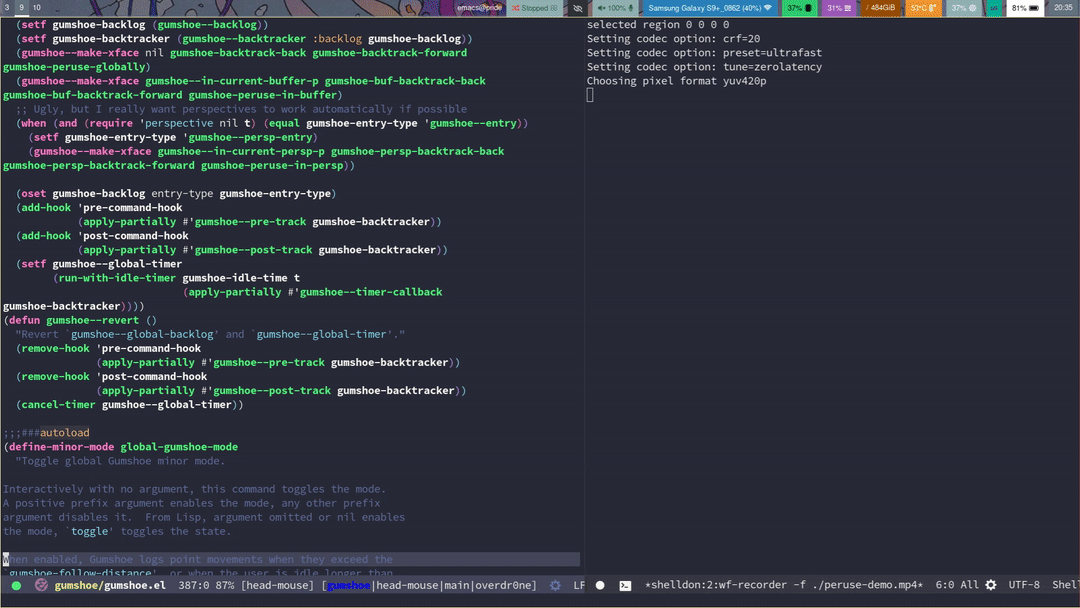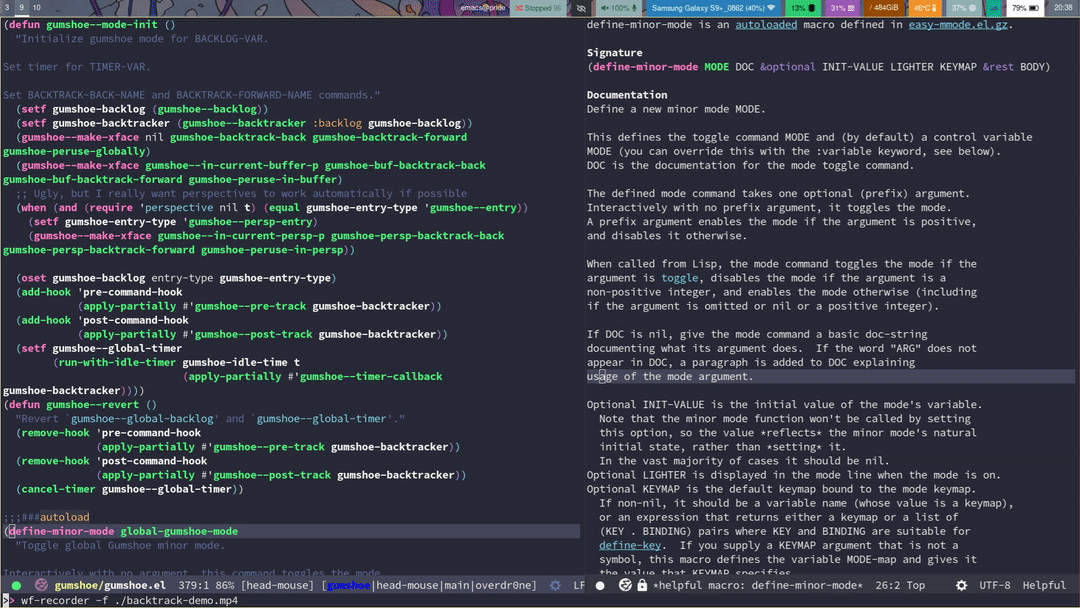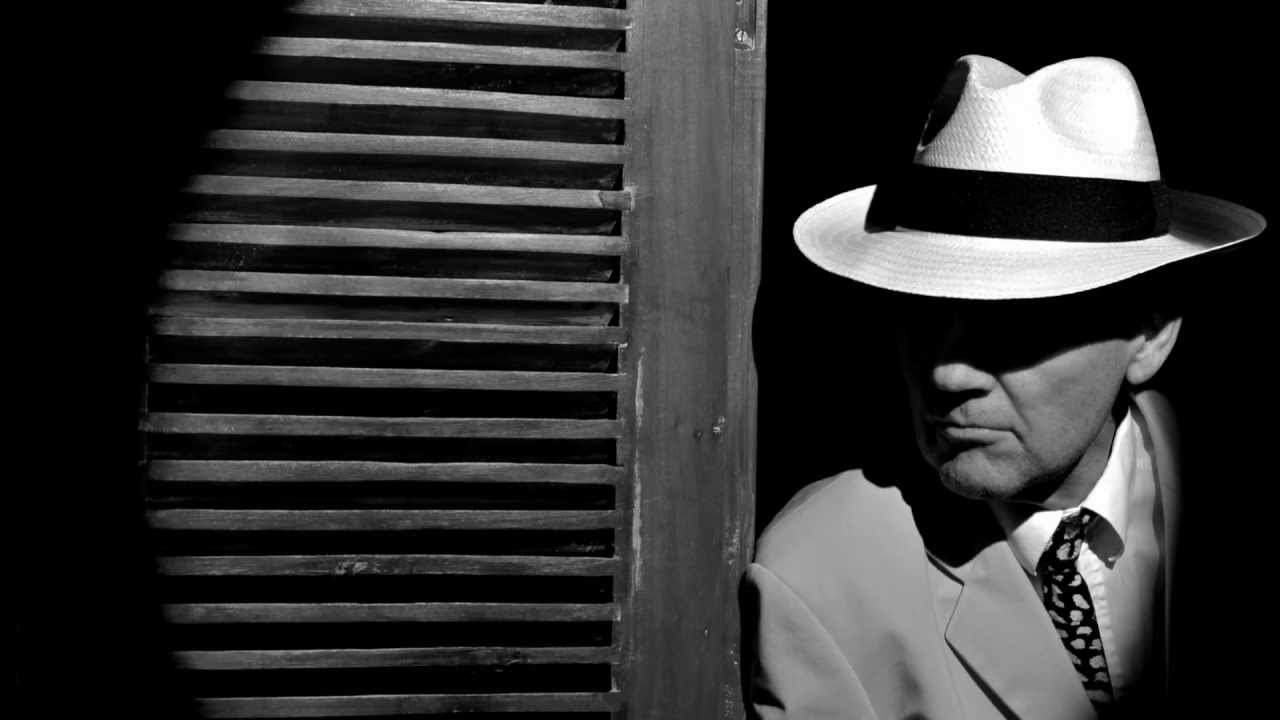Gumshoe is a daemon that quietly keep tabs on your Point movements so you can retrace your steps if you ever need a reminder of where you’ve been. Each mode keeps a log local to some scope.
 (This demonstrates the non-built-in gumshoe-peruse-globally command described below, because it’s the most visual. I usually just use gumshoe–backtrack-back/forward and its variants.)
(This demonstrates the non-built-in gumshoe-peruse-globally command described below, because it’s the most visual. I usually just use gumshoe–backtrack-back/forward and its variants.)
Gumshoe does not keep track of every move you make, rather, only at increments of some minimum Euclidean distance from the last tracked position, like a leash. It will also automatically log a position if you’ve idled there for a configurable amount of time. This package is very similar to Vim’s jump list, just generalized for Emacs.
I just use straight+use-package like so:
(use-package gumshoe
:straight (gumshoe :type git
:host github
:repo "Overdr0ne/gumshoe"
:branch "master")
:init
;; Enabing global-gumshoe-mode will initiate tracking
(global-gumshoe-mode +1)
;; customize peruse slot display if you like
(setf gumshoe-slot-schema '(time buffer position line))
;; personally, I use perspectives, so I use the provided extension
;; :after (perspective)
;; (global-gumshoe-persp-mode +1)
;; (setf gumshoe-slot-schema '(perspective time buffer position line))
)- Once global-gumshoe-mode is enabled, gumshoe will automatically start recording movements into the gumshoe-backlog ringbuffer.
- Configure Gumshoe’s euclidean follow distance by customizing the gumshoe-follow-distance variable.
- Configure Gumshoe’s idle time by customizing the gumshoe-idle-time variable.
- Configure the number of locations logged with the gumshoe-log-len variable.
- Horizontal distance is scaled down by a factor of 4 by default, since columns are approximately that much narrower than rows, but you can modify gumshoe-horizontal-scale if you want.
Backtracking works a bit like isearch or Vim’s jump-list. Point will jump sequentially between points in the backlog.

- Use gumshoe-backtrack-back and gumshoe-backtrack-forward to jump backwards and forwards in the log.
- There is built-in support for buffer-local backtracking using commands: gumshoe-buf-backtrack-back and gumshoe-buf-backtrack-forward, such that all logs can be tracked independently.
- I have also provided default support for perspective-local backtracking using commands: gumshoe-persp-backtrack-back and gumshoe-persp-backtrack-forward, such that all logs can be tracked independently.
- By default, Gumshoe also marks “footprints”, an overlay visually indicating entry points in the buffer. Toggle gumshoe-show-footprints-p to disable them.
You can also visually browse the backlog in the minibuffer with the peruse commands: gumshoe-peruse-globally, gumshoe-peruse-in-buffer and gumshoe–peruse-in-persp.
- Customize gumshoe-slot-schema to specify which, and in what order you would like entry fields displayed.
- Make your own peruse commands by providing a filter predicate to gumshoe–peruse.
- Gumshoe now uses ‘gumshoe–entries’ in the backlog instead of marks or bookmarks. I tried to make bookmarks work for me, but found the bookmark-alist far too ingrained into their interface and ended up finding it easier and more extensible to just make my own abstraction. It contains basically all the same metadata as a bookmark, but users/developers may add whatever metadata they want, by inheriting from it. That’s how I added the perspective field.
- peruse: this is my take on `dogears-list`. It uses completing read to browse through the backlog. The display is customizable, allowing users to specify what and in what order gumshoe–entry fields are selected.
- Noticing how similar backtracking is to isearch, I upgraded backtracking to also display ‘footprints’ which visually indicate maked positions while backtracking.
- Both backtracking and perusing be filtered programmatically by passing in a predicate function.
I generally noticed that the thing I was tracking was not so much the point position, but user context. And context I realized can cover a lot, and arguably, could cover the entire state of Emacs, or your computer, or, well, the universe at the moment that context is recorded. So rather than try to have gumshoe cover all possible definitions of context, I tried to just focus on the interface, and provide a clear path to extension, for me or anyone. So that’s where all the OO stuff came from. It’s not complete, but that’s where I’m going with it. The benefits may not be obvious at the time of this writing, but I hope will be as I add things.
If Gumshoe doesn’t suit you, here are some more Point history tracking packages that may.
- https://github.com/alphapapa/dogears.el Dogears is particularly similar to gumshoe. They both have automatic spatial and temporal tracking, and allows visual navigation of the log. There may actually be some sort of convergence of these packages at some point. It’s an open issue.
- https://github.com/blue0513/point-history
- https://github.com/tcw165/history
- https://github.com/dgutov/point-stack/
- https://github.com/rolandwalker/back-button
- https://github.com/gilbertw1/better-jumper
So why do we need gumshoe then? Gumshoe has:
- automatic temporal tracking and spatial tracking
- customizable log filters allow you to see just the information you want.
- customizable context metadata allows you to tell gumshoe exactly what you want logged.
- Built-in autocompletion using only completing-read.
- extensible scoping: if you can make arbitrary variables local to your scope, you can make a gumshoe mode for that scope. Scoped logs work independently, and don’t interfere with the global-mark-ring.
- works ootb without much configuration or dependency on external packages
Packages above may have one or two of these features, but changes on the order of a complete rewrite would be required to make them work like gumshoe. But comments are totally welcome if you’d like to open an issue.
- Gumshoe needs to know entry format before it begins tracking. This makes dynamically changing that format effectively impossible without reinitializing the mode.
- To require fields from multiple elpa/melpa packages requires defining a new class for each combination(to avoid multiple inheritance). This is good to a certain extent, to force me or anyone else to think about interactions between those packages, like, jump operations often need to be sequenced carefully to work as intended.
- The gumshoe–entry class is effectively a replacement of bookmarks. I’d like to maybe define an interface using cl-defgeneric that might just work for everything, so people could use a function like context–jump, and it would dispatch the correct method for bookmarks or gumshoe–entry, or whatever.
